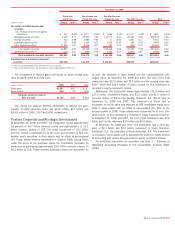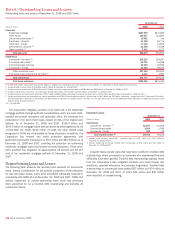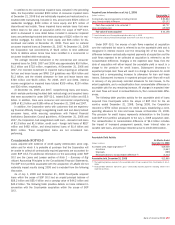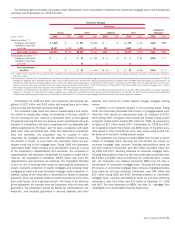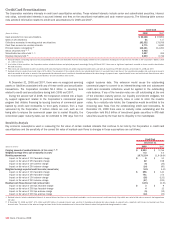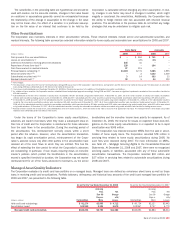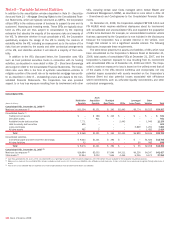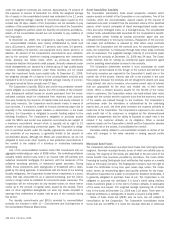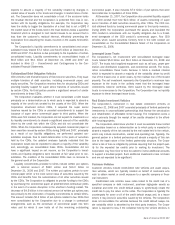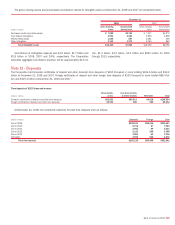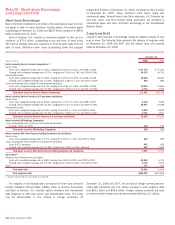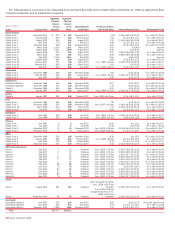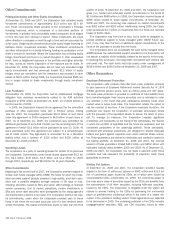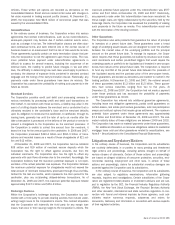Bank of America 2008 Annual Report Download - page 149
Download and view the complete annual report
Please find page 149 of the 2008 Bank of America annual report below. You can navigate through the pages in the report by either clicking on the pages listed below, or by using the keyword search tool below to find specific information within the annual report.expects to absorb a majority of the variability created by changes in
market value of assets in the trusts and changes in market rates of inter-
est. The Corporation does not consolidate a trust if the customer holds
the residual interest and the Corporation is protected from loss in con-
nection with its liquidity obligations. For example, the Corporation may
have the ability to trigger the liquidation of a trust that is not a QSPE if
the market value of the bonds held in the trust declines below a specified
threshold which is designed to limit market losses to an amount that is
less than the customer’s residual interest, effectively preventing the
Corporation from absorbing the losses incurred on the assets held within
the trust.
The Corporation’s liquidity commitments to consolidated and uncon-
solidated trusts totaled $7.2 billion and $13.5 billion at December 31,
2008 and 2007. The decline is due principally to the liquidation of certain
consolidated trusts. Liquidity commitments to unconsolidated trusts of
$6.8 billion and $6.1 billion at December 31, 2008 and 2007 are
included in Note 13 – Commitments and Contingencies to the Con-
solidated Financial Statements.
Collateralized Debt Obligation Vehicles
CDO vehicles hold diversified pools of fixed income securities. They issue
multiple tranches of debt securities, including commercial paper, and
equity securities. The Corporation receives fees for structuring CDOs and
providing liquidity support for super senior tranches of securities issued
by certain CDOs. No third parties provide a significant amount of similar
commitments to these CDOs.
The Corporation evaluates whether it must consolidate a CDO based
principally on a determination as to which party is expected to absorb a
majority of the credit risk created by the assets of the CDO. When the
Corporation structured certain CDOs, it acquired the super senior
tranches issued by the CDOs or provided commitments to support the
issuance of super senior commercial paper to third parties. When the
CDOs were first created, the Corporation did not expect its investments or
its liquidity commitments to absorb a significant amount of the variability
driven by the credit risk within the CDOs and did not consolidate the
CDOs. When the Corporation subsequently acquired commercial paper or
term securities issued by certain CDOs during 2008 and 2007, principally
as a result of our liquidity obligations, we performed updated con-
solidation analyses. Due to credit deterioration in the pools of securities
held by the CDOs, the updated analyses typically indicated that the
Corporation would now be expected to absorb a majority of the variability
and, accordingly, we consolidated these CDOs. Consolidation did not
have a significant impact on net income, as the Corporation’s invest-
ments and liquidity obligations were recorded at fair value prior to con-
solidation. The creditors of the consolidated CDOs have no recourse to
the general credit of the Corporation.
Liquidity commitments provided to CDOs include written put options
with a notional amount of $542 million and $10.0 billion at
December 31, 2008 and 2007. The written put options pertain to com-
mercial paper which is the most senior class of securities issued by the
CDOs and benefits from the subordination of all other securities issued
by the CDOs. The Corporation is obligated to provide funding to the CDOs
by purchasing the commercial paper at predetermined contractual yields
in the event of a severe disruption in the short-term funding market. The
decrease of $9.5 billion in the notional amount of written put options was
due primarily to the elimination of liquidity commitments to certain CDOs.
This amount includes $2.2 billion of put options related to two CDOs that
were consolidated by the Corporation due to a change in contractual
arrangements such as the conversion of commercial paper into term
notes and for which it now holds all of the remaining outstanding
commercial paper. It also includes $7.0 billion of put options that were
terminated due to liquidation of three CDOs.
At December 31, 2007, the Corporation also provided liquidity support
to a CDO conduit that held $2.3 billion of assets consisting of super
senior tranches of debt securities issued by other CDOs. The CDO con-
duit obtained funds by issuing commercial paper to third party investors.
During 2008, the Corporation purchased the assets and liquidated the
CDO conduit in accordance with our liquidity obligation due to a threat-
ened downgrade of the CDO conduit’s commercial paper. Four CDO
vehicles which issued securities formerly held in the CDO conduit are
consolidated on the Consolidated Balance Sheet of the Corporation at
December 31, 2008.
Leveraged Lease Trusts
The Corporation’s net involvement with consolidated leveraged lease
trusts totaled $5.8 billion and $6.2 billion at December 31, 2008 and
2007. The trusts hold long-lived equipment such as rail cars, power gen-
eration and distribution equipment, and commercial aircraft. The Corpo-
ration consolidates these trusts because it holds a residual interest
which is expected to absorb a majority of the variability driven by credit
risk of the lessee and, in some cases, by the residual risk of the leased
property. The net investment represents the Corporation’s maximum loss
exposure to the trusts in the unlikely event that the leveraged lease
investments become worthless. Debt issued by the leveraged lease
trusts is nonrecourse to the Corporation. The Corporation has no liquidity
exposure to these leveraged lease trusts.
Real Estate Investment Vehicles
The Corporation’s investment in real estate investment vehicles at
December 31, 2008 and 2007 consisted principally of limited partnership
investments in unconsolidated partnerships that finance the construction
and rehabilitation of affordable rental housing. The Corporation earns a
return primarily through the receipt of tax credits allocated to the afford-
able housing projects.
The Corporation determines whether it must consolidate these limited
partnerships based on a determination as to which party is expected to
absorb a majority of the risk created by the real estate held in the vehicle,
which may include construction, market and operating risk. Typically, the
general partner in a limited partnership will absorb a majority of this risk
due to the legal nature of the limited partnership structure. The Corpo-
ration’s risk of loss is mitigated by policies requiring that the project qual-
ify for the expected tax credits prior to making its investment. The
Corporation may from time to time be asked to invest additional amounts
to support a troubled project. Such additional investments have not been
and are not expected to be significant.
Customer Vehicles
Customer vehicles include credit-linked note vehicles and asset acquis-
ition vehicles, which are typically created on behalf of customers who
wish to obtain market or credit exposure to a specific company or finan-
cial instrument.
Credit-linked note vehicles issue notes linked to the credit risk of a
specified company or debt instrument, purchase high-grade assets as
collateral and enter into credit default swaps to synthetically create the
credit risk to pay the return on the notes. The Corporation is typically the
counterparty for some or all of the credit default swaps and, to a lesser
extent, it may invest in securities issued by the vehicles. The Corporation
does not consolidate the vehicles because the credit default swaps cre-
ate variability which is absorbed by the third party investors. The Corpo-
ration is exposed to loss if the collateral held by the vehicle declines in
Bank of America 2008
147


